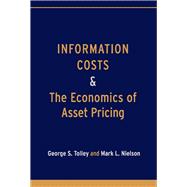An explanation of asset pricing is developed based on aggregating the portfolio choices of individual investors. Recognition is given to investor information costs. Portfolio risk is lowered by increasing the number of securities an investor holds, giving Markowitz-type diversification gains. Investigation costs required for any additional security raises costs. Investigation costs are pushed to the point where the marginal gain from diversifying to one more security just offsets the marginal loss from spreading information costs over an additional security.
The same comparison of marginal cost and marginal gain of adding a security applies to each security being considered for inclusion. The result is that every security in the portfolio chosen by the investor is of identical riskiness.
Investors sort to securities of their individual desired level of riskiness. Each investor holds only a small fraction of the total number of securities. They are in competition to buy the total supply of securities. Prices must be such that the market for all securities clears. As investors jockey for position in holding securities of varying riskiness, they will make bids only against those who have chosen securities of a similar risk level, since investors who have different risk preferences will be competing for securities of a different riskiness. While the investors will be ranked with riskier securities commanding higher returns,
there are many ways of ranking securities in such an order.
The impasse between competing investors is broken by the relative change in slope i.e. the relative change in rise in riskiness, or change as given by the second derivative of the risk-return relation as riskiness increases. Market stability requires that the second derivative of the market risk relation is negative.
The demand parameters of individual investors must be brought in, in such a way as to conform to the risk return slope conditions for the risk return relation, and these need to be related to the supply conditions for securities to ensure that demand and supply for securities at each level of security riskiness are equal. The derivative of the slope of the risk return relation is equal to the absolute value of the ratio of density of supply to density of demand at that level of riskiness. Expected return r is expected return on the least risky security r0 plus the integral of the slope dr/dR from that of the least risky security up to that of the security in question:
r=r0+R0?R{(dr/dR)0+R0?R[-j(R)/h(dr/dR)dR]dR}dR
This result is for the case where investors differ in risk aversion but their information cost functions are identical, as may be reasonable where brokers and other intermediary investors draw on similar pools of security analysts. The case of investors with dissimilar information cost functions is briefly considered as a prelude to explaining security market fluctuations and disequilibria.
The next part of the study embeds the asset pricing explanation of this book in a Lucas-type macroeconomic model. The asset pricing explanation developed in this book still applies, subject to the proviso that the least risky security held by any investor conforms to the Euler equation for optimal saving. The effects of risk on saving are explored, bringing out that the saving decision of the household is an endogenous choice.
Next the relation of the explanation of asset prices in this book to consumption capm is explored. In consumption capm every investor holds every asset, whereas in this book each investor holds only a few assets. Our explanation encounters no equity-premium puzzle.
Using historical U.S. data, we make a preliminary estimate of the long run risk return relation for the U.S. It has common sense appeal and paves the way for more refined estimation.








